
12 Amazing Species Discovered in 2012
New Discoveries
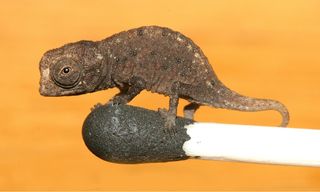
There are millions of species on Earth, but science has identified just a fraction of them. This year, various scientists around the world announced the discoveries of myriad species that had previously gone unnoticed, including a chameleon big enough to perch on the head of a match and a strange creature named for the Star Wars character Yoda.
Click through to find out more about these fascination creatures and how scientists found them.
Teeny tiny frog

Yes, that's a dime that frog is sitting on. The miniature amphibian (given the scientific name Paedophryne amanuensis), is reportedly the world's smallest vertebrate (the category of animals that have backbones). It was discovered the tropical rainforest of Papua New Guinea in 2009, but was only described in a scientific journal earlier this year. Scientists found it because of the high-pitched, cricket-like sound it made, according to the scientists that found it.
Itty Bitty Chameleon

Continuing with the Lilliputian discoveries, this chameleon discovered on a tiny island off Madagascar is small enough to perch on the head of a match (or a human finger, as in the picture above). Brookesia micra is the smallest known chameleon species and was one of four tiny chameleon species announced by a group of researchers earlier this year. The researchers warned that the species are threatened because of habitat loss and deforestation.
Acorn Worm Named After Yoda
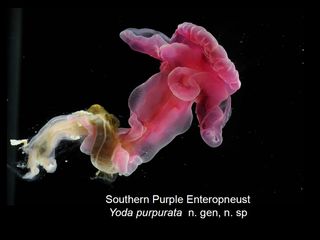
Strange, this creature looks. Named after Yoda, it is. The reddish-purple acorn worm was found about 1.5 miles (2.5 kilometers) beneath the surface of the Atlantic Ocean. The lips on either side of its head region reminded its discoverers of the "Star Wars" character Yoda, and so it was dubbed Yoda purpurata, or "purple Yoda." Deep sea acorn worms leave spiral traces of poop that resemble crop circles.
Long-legged arachnid

This isn't your average household daddy longleg. With a whopping 13-inch (33 centimeters) legspan, this arachnid is the largest harvestman ever found. Harvestman is another term for daddy longlegs, a type of arachnid commonly mistaken as a spider. The spindly creature was found in the caves of the Southeast Asian country of Laos during the filming of a TV show.
Mouse lemur
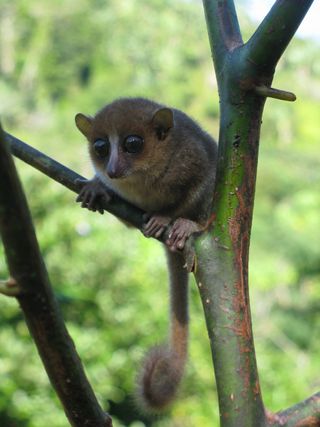
This little primate, about the size of a hamster, was found hiding among a dozen other lemur species in the rainforests of Madagascar. Named Microcebus gerpi, it is nocturnal and sticks to the lowland areas of the rain forest. The lowland areas of the rainforest that the mouse lemur inhabits aren't protected and are continually under threat from humans.
Reddish-purple crabs
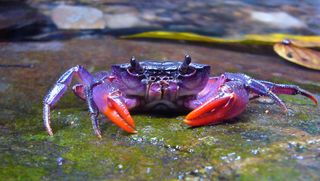
This brilliant purple crab was one of four new riotously colored crab species discovered near the Philippine island of Palawan and announced last spring. The four species, part of the genus Insulamon, are endemic to the area, meaning they are found nowhere else. They are threatened though, by mining activity in the region, which is one of the world's major biodiversity hotspots.
Sign up for the Live Science daily newsletter now
Get the world’s most fascinating discoveries delivered straight to your inbox.
Meat-eating sponge

One of the weirder-looking new species discoveries announced this year, this carnivorous deep sea sponge is shaped like a candelabra. It was first spotted by a remotely operated vehicle in the ocean off California's Monterey Bay in 2000; scientists later retrieved two of the sponges and got 10 hours of video of the creatures. The sponges use Velcro-like hooks on their branches to snag crustaceans floating by on ocean currents. The insights scientists gleaned into the sponge's life cycle were published this fall.
'Bumblebee' Gecko
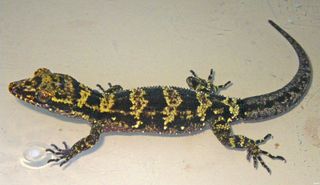
It may have the black-and-yellow stripes of a bumblebee, but this gecko is all lizard. The species (Nactus kunan) was discovered in Papua New Guinea. It's coloring, along with a row of nodules on its skin, help the bumblebee gecko blend in on the forest floor. A genetic analysis of the species showed that it was one that hadn't been described by science before.
Matilda's Horned Viper

Like the bumblebee gecko, this snake, a type of bush viper, has a striking black and yellow coloring, as well as hornlike scales above its eyes. Found during a biological survey in Tanzania, its discoverers are keeping its exact location a secret to keep it from falling prey to the illegal pet trade. The snake's habitat, thought to be only a few square miles of remote forest, is affected by logging and other human practices.
'Extinct' Galapagos Tortoise

This species wasn't so much discovered as re-discovered. Thought to be extinct for 150 years, the giant tortoise Chelonoidis elephantopus was found to in fact be alive and well when scientists analyzed the genome of a related species that lives on the same island where C. elephantopus was last spotted. They found markers of the C. elephantopus genetic code in the other species that was introduced recently enough that some of the C. elephantopus could still be alive. Researchers hope to find the hidden population and regenerate the species.

Andrea Thompson is an associate editor at Scientific American, where she covers sustainability, energy and the environment. Prior to that, she was a senior writer covering climate science at Climate Central and a reporter and editor at Live Science, where she primarily covered Earth science and the environment. She holds a graduate degree in science health and environmental reporting from New York University, as well as a bachelor of science and and masters of science in atmospheric chemistry from the Georgia Institute of Technology.
